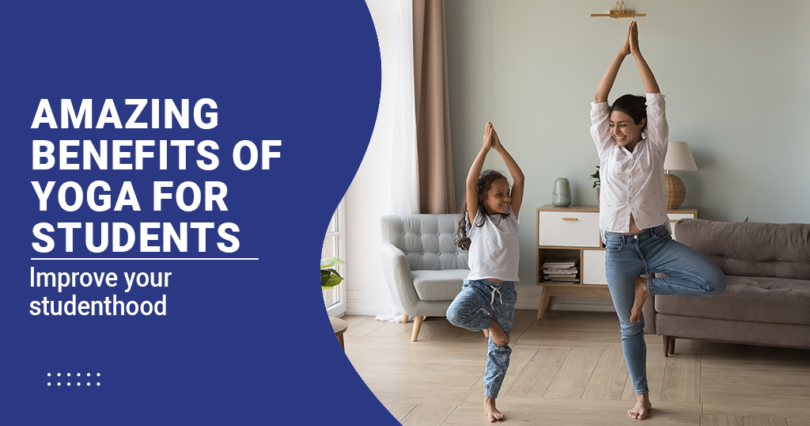
Welcome to our comprehensive guide on the benefits of yoga for students. In today’s fast-paced and demanding academic environment, students face various challenges, including stress, anxiety, and lack of focus. However, incorporating yoga into their daily routine can have a profound positive impact on their overall well-being and academic performance. The benefits of yoga for students are numerous and include enhanced physical fitness, improved mental clarity, and reduced stress levels. Through a series of asanas, pranayama, and meditation, yoga cultivates mindfulness and self-awareness, empowering students to navigate academic pressures more effectively. In this article, we will explore how yoga can holistically support students’ physical health, mental well-being, and academic success. Discover the transformative benefits of yoga for students and unlock their true potential on this rewarding journey of self-discovery.
Table of Contents
Stress Reduction Techniques: How Yoga Helps Students Cope with Academic Pressure
- **** Mindfulness: Yoga teaches students how to focus on the present moment and let go of negative thoughts and emotions. This can be helpful for students who are feeling stressed about exams, deadlines, or other academic stressors.
**** Breathing exercises: Yoga breathing exercises, such as pranayama, can help students to relax and calm their minds. This can be especially helpful during times of high stress.
- **** Stretching: Yoga stretches can help to improve flexibility and range of motion. This can be helpful for students who are feeling tense or sore from sitting in class all day.
**** Body awareness: Yoga teaches students to become more aware of their bodies and how they feel. This can help students to identify and address physical symptoms of stress, such as headaches, stomachaches, and muscle tension.
- **** Yoga Nidra: Yoga Nidra is a type of relaxation technique that combines yoga poses, breathing exercises, and visualization. It can be very helpful for students who are feeling overwhelmed or anxious.
Enhancing Focus and Concentration: The Impact of Yoga on Academic Performance
- In the fast-paced world of academia, students often face overwhelming challenges that demand unwavering focus and concentration. This is where the benefits of yoga for students truly shine. Through regular yoga practice, students can experience a profound improvement in their ability to concentrate on their studies and academic tasks. The mind-calming and centering effects of yoga help alleviate distractions, allowing students to delve deeper into their studies and absorb information more effectively. Moreover, yoga enhances cognitive functions and memory retention, enabling students to excel in their exams and coursework.
The benefits of yoga for students extend beyond the classroom as well. By incorporating yoga into their daily routines, students can experience reduced stress and anxiety levels, creating a positive impact on their overall well-being. As stress subsides, students can better manage their emotions and maintain a more balanced perspective throughout their academic journey. Yoga also promotes better sleep patterns, ensuring students are well-rested and rejuvenated, ready to face each day with renewed energy and enthusiasm.
- In essence, the practice of yoga brings a plethora of benefits to students, providing them with a holistic approach to achieving academic success while nurturing their physical, mental, and emotional well-being. Embracing the benefits of yoga for students empowers them to embark on their educational endeavors with confidence, focus, and a profound sense of self-awareness.
Physical Fitness and Flexibility: The Benefits of Yoga Poses for Students
Improved balance: Yoga poses help to improve balance by challenging the body to maintain equilibrium in a variety of positions. This can be helpful for students who are active in sports or who need to maintain a good balance for activities such as walking or biking.
Increased flexibility: Yoga poses help to increase flexibility by stretching the muscles and joints. This can be helpful for students who sit for long periods of time in class or who participate in activities that require a lot of flexibility, such as dance or gymnastics.
Strengthened core: Many yoga poses engage the core muscles, which are the muscles that support the spine and pelvis. Strong core muscles can help students to improve their posture, reduce back pain, and prevent injuries.
- Child’s pose: This pose is a great way to relax and stretch the back and hamstrings.
- Downward-facing dog: This pose is a great way to strengthen the core and improve balance.
- Warrior pose: This pose is a great way to improve strength, balance, and flexibility.
- Bridge pose: This pose is a great way to strengthen the core and improve flexibility in the hips and spine.
- Corpse pose: This pose is a great way to relax the body and mind.
Mental Clarity and Emotional Balance: Nurturing Well-being through Yoga
Improved focus and concentration: Yoga can help you to focus your mind and improve your concentration. This is because yoga teaches you to focus on your breath and the present moment, which can help to quiet the mind and reduce distractions.
- Reduced stress and anxiety: Yoga can help to reduce stress and anxiety by teaching you relaxation techniques such as deep breathing and meditation. These techniques can help to calm the mind and body, and they can be very helpful for people who are feeling overwhelmed or stressed.
Increased self-awareness: Yoga can help you to become more aware of your thoughts, feelings, and bodily sensations. This can be helpful for people who are struggling with emotional regulation or who are trying to improve their self-esteem.
- Improved sleep: Yoga can help to improve sleep by promoting relaxation and reducing stress. When you’re relaxed and less stressed, it’s easier to fall asleep and stay asleep.
Enhanced mood: Yoga can help to improve mood by increasing levels of the neurotransmitters serotonin and dopamine. These neurotransmitters are associated with feelings of happiness, well-being, and relaxation.
Yoga for Better Sleep: Improving Rest and Rejuvenation in Students
In today’s fast-paced academic environment, students often face challenges with sleep and rest. The benefits of yoga for students extend beyond physical flexibility and mental clarity; it can significantly impact their sleep patterns and overall well-being. Incorporating yoga into their daily routine can offer students a natural remedy for better sleep and improved rejuvenation. The gentle stretching and relaxation techniques in yoga help alleviate stress and anxiety, promoting a peaceful state of mind before bedtime. By cultivating mindfulness and focusing on the breath, students can quiet their thoughts and enter a state of tranquility conducive to deep and restorative sleep. Embracing the benefits of yoga for students not only enhances their academic performance but also fosters a healthier lifestyle and overall sense of balance. With consistent practice, students can experience the transformative power of yoga in improving their sleep and well-being.
Building Resilience: How Yoga Prepares Students to Face Challenges
- In the dynamic world of education, students encounter various challenges that demand resilience and adaptability. The benefits of yoga for students extend beyond the physical realm; they encompass mental and emotional well-being as well. Through consistent practice, yoga equips students with valuable tools to navigate the ups and downs of academic life and beyond. Yoga fosters self-awareness and mindfulness, enabling students to recognize and manage stress effectively. As they learn to synchronize breath with movement, students develop a sense of inner calm and focus that can be carried into their daily lives. Moreover, the benefits of yoga for students include enhanced concentration and improved emotional regulation, empowering them to face challenges with composure and clarity. By promoting self-compassion and positive self-talk, yoga builds a strong foundation for resilience, helping students bounce back from setbacks and embrace growth. Embracing the benefits of yoga for students can lead to a more balanced and resilient approach to life’s obstacles.
Promoting Positive Body Image: Boosting Self-Esteem through Yoga Practice
- **** Mindfulness: Yoga teaches you to focus on your breath and the present moment, which can help you to become more aware of your thoughts and feelings about your body. This awareness can help you to challenge negative body image thoughts and develop a more positive attitude towards your body.
**** Acceptance: Yoga teaches you to accept your body as it is, flaws and all. This can be a challenge for people who have negative body image, but it is an important step towards developing a more positive attitude towards your body.
- **** Strength: Yoga can help you to build strength and flexibility, which can improve your body image. When you feel strong and capable, you are more likely to see your body in a positive light.
**** Community: Yoga can be a great way to connect with other people who are also trying to improve their body image. This sense of community can be very supportive and can help you to feel more confident in your own skin.
- **** Non-judgment: Yoga is a non-judgmental practice, which means that there is no pressure to look or perform a certain way. This can be very liberating for people who have negative body image, as it allows them to focus on the process of yoga rather than on their appearance.
Improving Posture and Spinal Health: The Role of Yoga in Student Wellness
In the fast-paced and demanding academic environment, students often experience the effects of prolonged sitting, such as poor posture and potential spinal health issues. However, the ancient practice of yoga has emerged as a powerful tool to counter these challenges and promote student wellness. One of the key benefits of yoga for students is its positive impact on posture and spinal health. Through a series of asanas and stretches, yoga encourages students to be mindful of their body alignment and engage their core muscles effectively. This, in turn, helps in correcting poor posture and promoting a healthier spine. Regular practice of yoga can also alleviate the stiffness and tension that builds up from long hours of studying or sitting, leading to a more flexible and agile body. As students incorporate yoga into their routine, they can experience firsthand the transformative benefits of yoga for their physical and mental well-being. Ultimately, yoga serves as a holistic approach to improving posture and spinal health, contributing to overall student wellness.
Cultivating Mindfulness: The Connection Between Yoga and Improved Study Habits
- In the modern digital age, where distractions abound and attention spans are dwindling, cultivating mindfulness has become crucial for students’ academic success. Yoga, with its emphasis on breath control and present-moment awareness, offers a powerful means to enhance students’ study habits. One of the notable benefits of yoga for students is its ability to foster mindfulness. By engaging in yoga practice, students learn to be fully present in the moment, letting go of racing thoughts and external pressures. This newfound sense of mindfulness translates into improved study habits, as students become more focused, attentive, and absorbed in their learning tasks. Moreover, yoga provides a sanctuary amidst academic pressures, offering a space for self-reflection and inner calmness. As students regularly incorporate yoga into their routines, they may notice a positive shift in their study approach, resulting in better retention, comprehension, and overall academic performance. The practice of yoga indeed intertwines with the improvement of study habits, demonstrating the profound benefits of yoga for students’ mental and emotional well-being.
Yoga for Social and Emotional Learning: Strengthening Interpersonal Skills in Students
Yoga’s impact on students extends beyond the physical and cognitive realms, reaching into the realm of social and emotional learning. The benefits of yoga for students in terms of developing interpersonal skills are profound. Through yoga practice, students are encouraged to explore their emotions, develop self-awareness, and build empathy toward others. This process of self-discovery and emotional regulation fosters a positive and harmonious learning environment. Yoga provides a safe space for students to express themselves authentically, free from judgment or criticism. As they engage in group yoga sessions, students learn to collaborate, communicate effectively, and respect each other’s boundaries. These essential social skills are invaluable in nurturing healthy relationships and fostering a supportive peer community. Moreover, the practice of yoga helps students manage stress, anxiety, and conflicts, empowering them to navigate challenges with resilience and compassion. The incorporation of yoga into educational settings contributes significantly to students’ social and emotional growth, showcasing the multifaceted benefits of yoga for students’ holistic development.
Conclusion
In conclusion, the benefits of yoga for students are diverse and far-reaching. From enhancing focus and academic performance to fostering emotional well-being and resilience, yoga proves to be a powerful tool for student development. Its positive impact on physical health, mental clarity, and social skills makes it an invaluable addition to educational environments. Embracing yoga as a regular practice empowers students to navigate the challenges of academia and life with greater ease and balance. The holistic advantages of yoga for students reaffirm its significance in promoting overall well-being and empowering the next generation of learners. Embrace the benefits of yoga for students and witness their transformational journey towards a harmonious and thriving educational experience.
Read Also The Best Yoga Poses for Weight Loss “A Beginner’s Guide”







